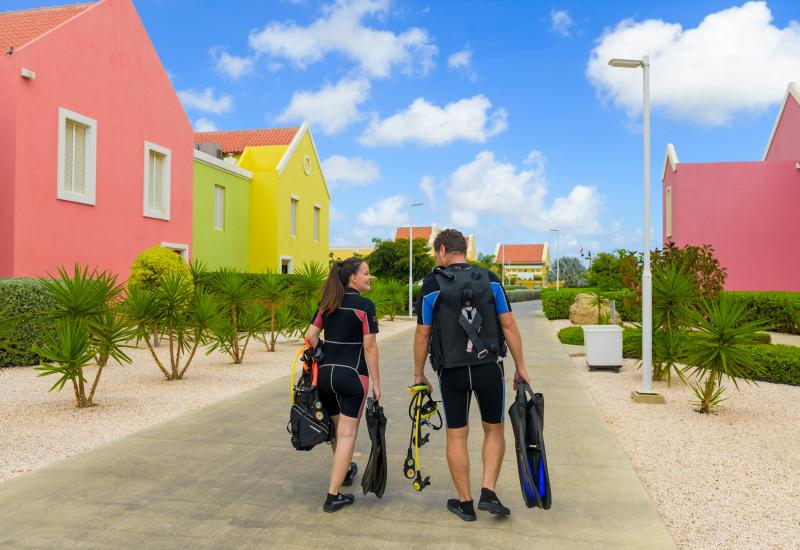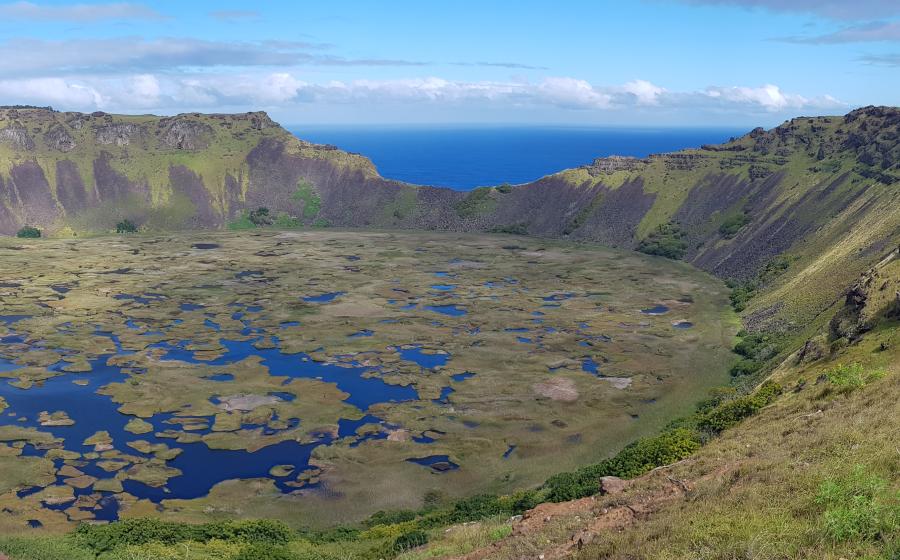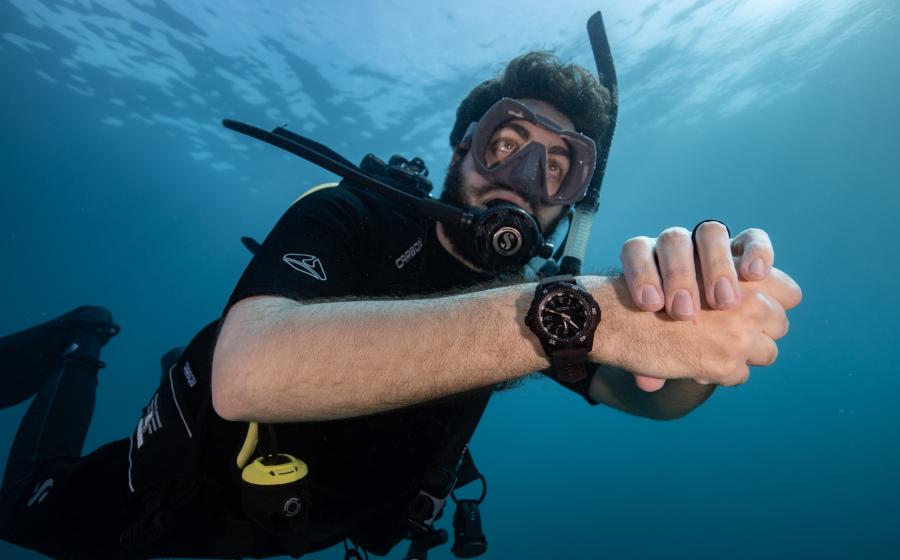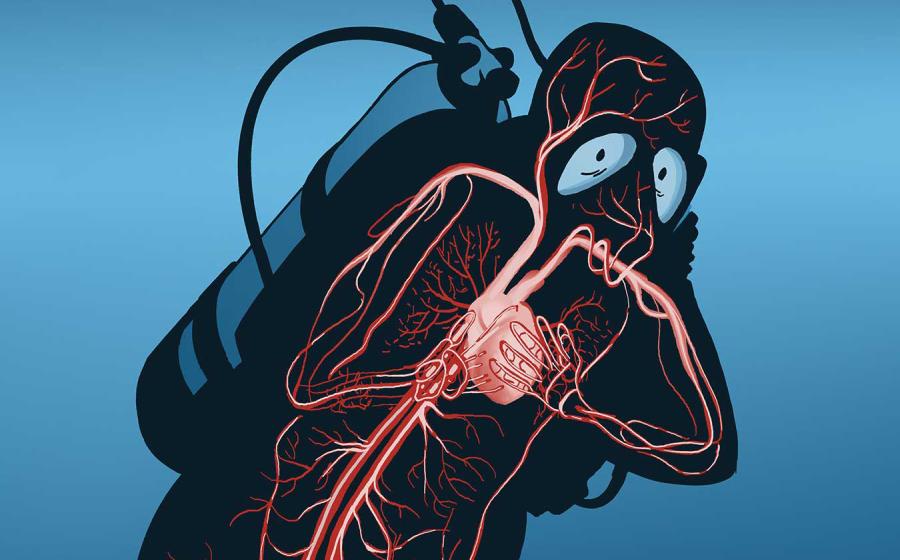Bahamas Travel Information
 General Destination Information: With 700 islands, 2,500 tiny cays, and 100,000 square miles of ocean containing it all, the Bahamas collectively comprise a massive scuba and snorkel paradise. Yet to know but one part of the Bahamas is to experience a small vignette of a grand and impressive whole. I've found that these islands justify a lifetime of exploration, for the dive and snorkel opportunities are diverse and constantly evolving.
General Destination Information: With 700 islands, 2,500 tiny cays, and 100,000 square miles of ocean containing it all, the Bahamas collectively comprise a massive scuba and snorkel paradise. Yet to know but one part of the Bahamas is to experience a small vignette of a grand and impressive whole. I've found that these islands justify a lifetime of exploration, for the dive and snorkel opportunities are diverse and constantly evolving.
History: Even though the islands of the Bahamas are geographically near to the United States, stretching from just 70 miles east of the Palm Beaches to 750 miles to the south, their culture today and their historical development has been quite different. As is the case with many islands in this hemisphere, Columbus was the first European to sight these islands. As any schoolchild knows, popular convention suggests that his first landfall was October 12, 1492, at San Salvador in the Southern Bahamas. Not that it matters in the total scheme of things today, but other researchers suggest that the first landfall might have been at Samana Cay, some 60 miles to the southeast of San Salvador.
In either case, the first local residents Columbus met were probably Arawak Indians, refugees from elsewhere in the Caribbean seeking to escape the vicious Carib Indians around the beginning of the 9th century. Shy and gentle, the Arawaks offered great hospitality to the crew of the Nina, Pinta, and Santa Maria, but to their ultimate dismay, the Spaniards were enamored of the gold trinkets they wore. Later incursions by the Spanish forced the Arawaks to work in the gold and silver mines of the New World, effectively decimating the local population with overwork and disease by 1520.
The Spanish phrase "Baja Mar," for "shallow sea," was the derivation for the name Bahamas, but in later years the English had far more to do with the development of these islands than did the Spanish. By 1629, King Charles I claimed the Bahamas for England and by 1648 English pilgrims fleeing religious persecution back home settled on an island they called Eleuthera, after the Greek word for freedom. By the 1650s, another group of English immigrants settled on an island they called New Providence due to their family links with a settlement at Providence, Rhode Island. By the end of the 17th century there were over 1,000 British living in the islands of the Bahamas, trying to eke sustenance from farming, fishing, and salvaging the occasional Spanish galleon that still ran aground.
Piracy was part of the local culture back then, and some of the most notorious buccaneers of the day like Edward Teach (Blackbeard), Henry Morgan, and Calico Jack Rackham consistently raided the Spanish galleons transiting these waters. This enraged the British government, causing them to attack Charles Town on New Providence, burning much of it to the ground. The city was later rebuilt as Nassau, named in honor of King William III of Orange-Nassau.
By 1718, the end of piracy was virtually assured with the installation of former pirate Woodes Rogers as the first Royal Governor of the Bahamas. He riveted the attention of his former associates by hanging eight pirates in a single day in downtown Nassau, and inspired the country's first motto: Expulsis piratis, restitua comercia (Piracy expelled, commerce restored). In 1973 on the occasion of the Bahamas' independence from Britain, then Prime Minister Linden Pindling rewrote the motto with the current "Forward, Upward, Onward, Together."9
Experiments with agriculture on these islands were largely met with frustration due to the typically arid climate and poor soil. Plantation life never really took hold here and 1834 saw the freeing any slaves left behind as plantation owners moved elsewhere in the Caribbean. Even though farming was essentially a bust, this island's perfect climate and immense natural beauty suggested a potential tourist industry as early as 1861 when the first hotel on Nassau, the Royal Victoria, was built to accommodate the business and pleasure travel of the era.
Prohibition in the United States brought a temporary boon to the business interests of the Bahamas as rumrunning became a cottage industry in Nassau, Bimini, and the West End of Grand Bahama. But tourism was the steadier growth industry, and by 1929 Pan American Airways began making daily flights from Miami to Nassau. The Vanderbilts and the Astors were likely to winter in these islands in their majestic yachts, and the attraction these islands had to the aristocracy soon trickled down to the masses.
While New Providence was the first island to enjoy true resort hotels and regular air service, the rest of these islands were being simultaneously discovered by the fun-in-the-sun set. Gradual growth in tourism resulted in ever-increasing infrastructure for hedonistic pursuits. Golf courses and tennis courts were built at grand resort hotels, and marinas were constructed to provide for the needs of visiting yachtsmen. The wealth of offshore marine life made these islands a Nirvana for sport anglers. For those seeking a less active or consumptive recreation, there were hundreds, perhaps thousands of miles of unspoiled beach to stroll.
 As soon as facemasks became available, snorkelers were peering beneath the surface of these incredibly crystalline waters to marvel at one of the world's great coral reef ecosystems. By 1960, the world's first destination resort for scuba diving had opened in Freeport, Grand Bahama. Scuba diving and snorkeling became inexorably tied to the future of tourism in these islands.
As soon as facemasks became available, snorkelers were peering beneath the surface of these incredibly crystalline waters to marvel at one of the world's great coral reef ecosystems. By 1960, the world's first destination resort for scuba diving had opened in Freeport, Grand Bahama. Scuba diving and snorkeling became inexorably tied to the future of tourism in these islands.
Climate: The reason these islands are so perfectly suited to watersports has much to do with their incredible expanse of warm, clear water, and the diverse underwater attractions contained within. One hundred thousand square miles of Atlantic Ocean wouldn't mean much to the sport diver if it were all cold and deep, but in the Bahamas much of this resource lies between the limits of sport diving at 130 feet and within inches below the surface. There are wrecks, reefs, walls, and all manner of marine life; from marine mammals to reef tropicals to perhaps the world's most fascinating shark population. The Bahamas is probably the world's most diverse dive destination, but to understand what is different among these 700 islands, it's important to know what is the same. A highly favorable climate is one common denominator.
The Tropic of Cancer, the traditional determinant of all things "tropical," actually bisects these islands, passing through Long Island and the south end of the Exuma chain. The prevailing climate is moderated somewhat by the influence of the Gulf Stream, a warm oceanic current flowing from the southern Caribbean to the northeastern United States and beyond.
Still, there is a climactic difference between the southern and northern Bahamas as would be expected by a difference of 750 miles in latitude. In the north it is possible to feel the influence of the same sort of winter cold fronts that might affect South Florida. Occasionally, the air temperatures dip into the 60s at night, but a more reasonable expectation is daytime highs of 78 degrees dropping to 70 at night, and for summer perhaps ten degrees warmer overall, bringing air temperatures into the 80s both day and night. In the southern Bahamas, the temperature year-round is 5 degrees warmer on average.
As far as I'm concerned, and this probably reflects the opinion of most traveling scuba enthusiasts, the more important weather consideration is water temperature and wind velocity, for both affect potential dive enjoyment. In the winter the water temperature may drop to the mid-70s up north to the high-70s in the southern islands. The summer is absolutely idyllic with water temperatures ranging from the mid- to upper 80s throughout the island chain, making thermal protection unnecessary except perhaps when making multiple dives or night dives.
Wind is a huge variable for divers however. In the summer, from May through October, the prevailing winds are gentle tradewinds that do little to stir the seas. Days of slick calm are the norm and the difference between windward and leeward sides of the island an irrelevant dive determinant. During this period, water clarity of 100 to even 200 feet in some places can be expected. Of course, summer and fall are also hurricane season, but under normal weather patterns, summer diving in the Bahamas is among the best anywhere in the Western Hemisphere.
Geography: In many respects the geography is similar, although certainly not identical, from island to island. At one time when the global seas were lower, these islands were part of a large interconnected landmass. As the Ice Age ended and the seawater held frozen at the polar caps melted, the rising sea level made islands of the higher peaks and created a vast submarine plateau known as the Great Bahama Bank. The highest point in the Bahamas is now just 206 feet at Cat Island and only 5,400 square miles of land remains above sea level. There are deep oceanic trenches such as the Tongue of the Ocean that plunge to more than 6,000 feet, as well mangrove forests, shallow sand banks, isolated patch reefs, and extensive fringing reefs surrounding most of the islands, all of which contribute to the dive diversity.
The islands are typically low lying and rimmed by sugary sand beach and dotted with casuarina, pine, and palm trees. Some islands like New Providence and Grand Bahama feature well developed metropolitan centers world renown for their banking, casinos, and shopping. Others are typified by tiny villages where the local populace survives by fishing, a little farming, and providing services to the tourists who come to sample their unique pleasures. These are islands of subtle contrast, where each offers its own unique reward for the visiting watersports enthusiast.
Travel Miscellany
Entry: A passport is required. Departure tax is $18 from Grand Bahama, $15 from New Providence.
Money: The legal tender is the Bahamaian dollar, but it is on par with the U.S. dollar and used interchangeably. Traveler's checks and major credit cards are accepted.
Language: English is spoken universally, albeit with a distinct island lilt in some cases.
Electricity: The electric service is 120 volts, 60 cycles, just like in the U.S.
Time: The time zone is Eastern Standard Time (GMT+5) from the last Sunday in October through the last Saturday in April, and Eastern Standard Daylight Time (GMT+4) from the first Sunday in April to the last Saturday in October.
Car rentals: Visitors to the Bahamas may drive on their own license for up to 3 months. In the Bahamas, drive on the left side of the road.
Gratuities: Tipping is customary for live-aboards in this hemisphere, and is usually calculated at 10% of the package price.
Destination Links: www.bahamas.com, www.bahamasdiving.com
 General Destination Information: With 700 islands, 2,500 tiny cays, and 100,000 square miles of ocean containing it all, the Bahamas collectively comprise a massive scuba and snorkel paradise. Yet to know but one part of the Bahamas is to experience a small vignette of a grand and impressive whole. I've found that these islands justify a lifetime of exploration, for the dive and snorkel opportunities are diverse and constantly evolving.
General Destination Information: With 700 islands, 2,500 tiny cays, and 100,000 square miles of ocean containing it all, the Bahamas collectively comprise a massive scuba and snorkel paradise. Yet to know but one part of the Bahamas is to experience a small vignette of a grand and impressive whole. I've found that these islands justify a lifetime of exploration, for the dive and snorkel opportunities are diverse and constantly evolving.
History: Even though the islands of the Bahamas are geographically near to the United States, stretching from just 70 miles east of the Palm Beaches to 750 miles to the south, their culture today and their historical development has been quite different. As is the case with many islands in this hemisphere, Columbus was the first European to sight these islands. As any schoolchild knows, popular convention suggests that his first landfall was October 12, 1492, at San Salvador in the Southern Bahamas. Not that it matters in the total scheme of things today, but other researchers suggest that the first landfall might have been at Samana Cay, some 60 miles to the southeast of San Salvador.
In either case, the first local residents Columbus met were probably Arawak Indians, refugees from elsewhere in the Caribbean seeking to escape the vicious Carib Indians around the beginning of the 9th century. Shy and gentle, the Arawaks offered great hospitality to the crew of the Nina, Pinta, and Santa Maria, but to their ultimate dismay, the Spaniards were enamored of the gold trinkets they wore. Later incursions by the Spanish forced the Arawaks to work in the gold and silver mines of the New World, effectively decimating the local population with overwork and disease by 1520.
The Spanish phrase "Baja Mar," for "shallow sea," was the derivation for the name Bahamas, but in later years the English had far more to do with the development of these islands than did the Spanish. By 1629, King Charles I claimed the Bahamas for England and by 1648 English pilgrims fleeing religious persecution back home settled on an island they called Eleuthera, after the Greek word for freedom. By the 1650s, another group of English immigrants settled on an island they called New Providence due to their family links with a settlement at Providence, Rhode Island. By the end of the 17th century there were over 1,000 British living in the islands of the Bahamas, trying to eke sustenance from farming, fishing, and salvaging the occasional Spanish galleon that still ran aground.
Piracy was part of the local culture back then, and some of the most notorious buccaneers of the day like Edward Teach (Blackbeard), Henry Morgan, and Calico Jack Rackham consistently raided the Spanish galleons transiting these waters. This enraged the British government, causing them to attack Charles Town on New Providence, burning much of it to the ground. The city was later rebuilt as Nassau, named in honor of King William III of Orange-Nassau.
By 1718, the end of piracy was virtually assured with the installation of former pirate Woodes Rogers as the first Royal Governor of the Bahamas. He riveted the attention of his former associates by hanging eight pirates in a single day in downtown Nassau, and inspired the country's first motto: Expulsis piratis, restitua comercia (Piracy expelled, commerce restored). In 1973 on the occasion of the Bahamas' independence from Britain, then Prime Minister Linden Pindling rewrote the motto with the current "Forward, Upward, Onward, Together."9
Experiments with agriculture on these islands were largely met with frustration due to the typically arid climate and poor soil. Plantation life never really took hold here and 1834 saw the freeing any slaves left behind as plantation owners moved elsewhere in the Caribbean. Even though farming was essentially a bust, this island's perfect climate and immense natural beauty suggested a potential tourist industry as early as 1861 when the first hotel on Nassau, the Royal Victoria, was built to accommodate the business and pleasure travel of the era.
Prohibition in the United States brought a temporary boon to the business interests of the Bahamas as rumrunning became a cottage industry in Nassau, Bimini, and the West End of Grand Bahama. But tourism was the steadier growth industry, and by 1929 Pan American Airways began making daily flights from Miami to Nassau. The Vanderbilts and the Astors were likely to winter in these islands in their majestic yachts, and the attraction these islands had to the aristocracy soon trickled down to the masses.
While New Providence was the first island to enjoy true resort hotels and regular air service, the rest of these islands were being simultaneously discovered by the fun-in-the-sun set. Gradual growth in tourism resulted in ever-increasing infrastructure for hedonistic pursuits. Golf courses and tennis courts were built at grand resort hotels, and marinas were constructed to provide for the needs of visiting yachtsmen. The wealth of offshore marine life made these islands a Nirvana for sport anglers. For those seeking a less active or consumptive recreation, there were hundreds, perhaps thousands of miles of unspoiled beach to stroll.
 As soon as facemasks became available, snorkelers were peering beneath the surface of these incredibly crystalline waters to marvel at one of the world's great coral reef ecosystems. By 1960, the world's first destination resort for scuba diving had opened in Freeport, Grand Bahama. Scuba diving and snorkeling became inexorably tied to the future of tourism in these islands.
As soon as facemasks became available, snorkelers were peering beneath the surface of these incredibly crystalline waters to marvel at one of the world's great coral reef ecosystems. By 1960, the world's first destination resort for scuba diving had opened in Freeport, Grand Bahama. Scuba diving and snorkeling became inexorably tied to the future of tourism in these islands.
Climate: The reason these islands are so perfectly suited to watersports has much to do with their incredible expanse of warm, clear water, and the diverse underwater attractions contained within. One hundred thousand square miles of Atlantic Ocean wouldn't mean much to the sport diver if it were all cold and deep, but in the Bahamas much of this resource lies between the limits of sport diving at 130 feet and within inches below the surface. There are wrecks, reefs, walls, and all manner of marine life; from marine mammals to reef tropicals to perhaps the world's most fascinating shark population. The Bahamas is probably the world's most diverse dive destination, but to understand what is different among these 700 islands, it's important to know what is the same. A highly favorable climate is one common denominator.
The Tropic of Cancer, the traditional determinant of all things "tropical," actually bisects these islands, passing through Long Island and the south end of the Exuma chain. The prevailing climate is moderated somewhat by the influence of the Gulf Stream, a warm oceanic current flowing from the southern Caribbean to the northeastern United States and beyond.
Still, there is a climactic difference between the southern and northern Bahamas as would be expected by a difference of 750 miles in latitude. In the north it is possible to feel the influence of the same sort of winter cold fronts that might affect South Florida. Occasionally, the air temperatures dip into the 60s at night, but a more reasonable expectation is daytime highs of 78 degrees dropping to 70 at night, and for summer perhaps ten degrees warmer overall, bringing air temperatures into the 80s both day and night. In the southern Bahamas, the temperature year-round is 5 degrees warmer on average.
As far as I'm concerned, and this probably reflects the opinion of most traveling scuba enthusiasts, the more important weather consideration is water temperature and wind velocity, for both affect potential dive enjoyment. In the winter the water temperature may drop to the mid-70s up north to the high-70s in the southern islands. The summer is absolutely idyllic with water temperatures ranging from the mid- to upper 80s throughout the island chain, making thermal protection unnecessary except perhaps when making multiple dives or night dives.
Wind is a huge variable for divers however. In the summer, from May through October, the prevailing winds are gentle tradewinds that do little to stir the seas. Days of slick calm are the norm and the difference between windward and leeward sides of the island an irrelevant dive determinant. During this period, water clarity of 100 to even 200 feet in some places can be expected. Of course, summer and fall are also hurricane season, but under normal weather patterns, summer diving in the Bahamas is among the best anywhere in the Western Hemisphere.
Geography: In many respects the geography is similar, although certainly not identical, from island to island. At one time when the global seas were lower, these islands were part of a large interconnected landmass. As the Ice Age ended and the seawater held frozen at the polar caps melted, the rising sea level made islands of the higher peaks and created a vast submarine plateau known as the Great Bahama Bank. The highest point in the Bahamas is now just 206 feet at Cat Island and only 5,400 square miles of land remains above sea level. There are deep oceanic trenches such as the Tongue of the Ocean that plunge to more than 6,000 feet, as well mangrove forests, shallow sand banks, isolated patch reefs, and extensive fringing reefs surrounding most of the islands, all of which contribute to the dive diversity.
The islands are typically low lying and rimmed by sugary sand beach and dotted with casuarina, pine, and palm trees. Some islands like New Providence and Grand Bahama feature well developed metropolitan centers world renown for their banking, casinos, and shopping. Others are typified by tiny villages where the local populace survives by fishing, a little farming, and providing services to the tourists who come to sample their unique pleasures. These are islands of subtle contrast, where each offers its own unique reward for the visiting watersports enthusiast.
Travel Miscellany
Entry: A passport is required. Departure tax is $18 from Grand Bahama, $15 from New Providence.
Money: The legal tender is the Bahamaian dollar, but it is on par with the U.S. dollar and used interchangeably. Traveler's checks and major credit cards are accepted.
Language: English is spoken universally, albeit with a distinct island lilt in some cases.
Electricity: The electric service is 120 volts, 60 cycles, just like in the U.S.
Time: The time zone is Eastern Standard Time (GMT+5) from the last Sunday in October through the last Saturday in April, and Eastern Standard Daylight Time (GMT+4) from the first Sunday in April to the last Saturday in October.
Car rentals: Visitors to the Bahamas may drive on their own license for up to 3 months. In the Bahamas, drive on the left side of the road.
Gratuities: Tipping is customary for live-aboards in this hemisphere, and is usually calculated at 10% of the package price.
Destination Links: www.bahamas.com, www.bahamasdiving.com










